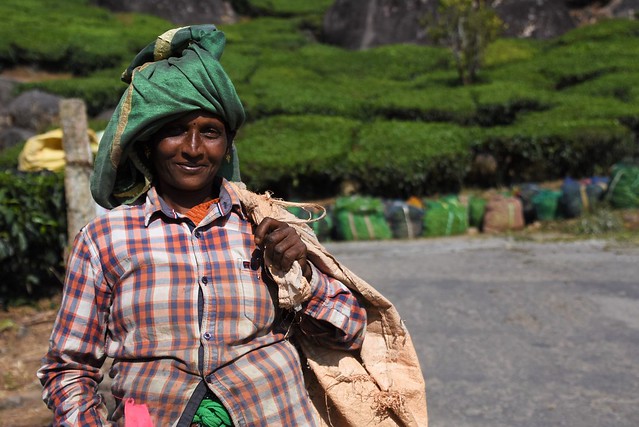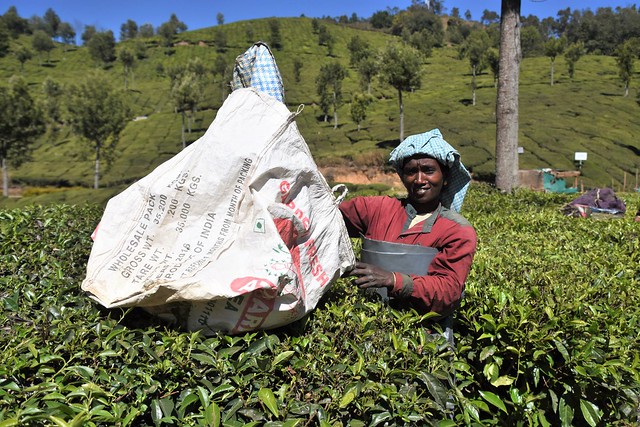The hills of Munnar, India.
Emerald leaves flutter under a bright blue sky. Sleek red dragonflies dart to and fro above the green, wings catching the sunlight. The leaves belong to bushels of tea — long, winding ranks of them, vast fields of jade-coloured shrubs sprawling for miles and miles and miles along rolling hills.
Munnar, located 1,600 metres above sea level, is a hill station in the Indian state of Kerala, situated in the Western Ghats mountain range. Frequently compared to both Kashmir and Darjeeling, its scenic mix of mountains and tea plantations make it a popular tourist destination, in particular for honeymooning couples.
One of Munnar’s premiere attractions is a small museum devoted entirely to the local tea trade, and visitors to the museum are promptly treated to a short film telling the story of the region’s history. In 1877, British Resident John Daniel Munro visited Munnar while settling a border dispute between the Kingdom of Travancore and the neighbouring state of Madras. Judging the Kannan Devan hills in Munnar to be prime plantation land, Munro promptly leased them from a local royal, the august Rohini Thirunal Kerala Varma Valiya Raja. In 1880, a European planter named A.H. Sharp experimented with planting tea in the Munnar area, and tea rapidly became the region's most successful crop.
In the late 1890s, the firm Finlay Muir & Company purchased 137,000 acres of tea estates in Munnar, and formed the Kannan Devan Hills Produce Company to manage them. In 1973, the Tata Group (India’s leading ubiquitous corporate conglomerate), purchased the Finley company. Its subsidiary, Tata Tea Limited, fully took over the plantations of Munnar in 1983. In 2005, Tata Tea ceased its operations in Munnar, handing its tea business over to the newly established Kannan Devan Hills Plantations Company (KDHP) — a company majority-owned by its plantation worker employees.
To this day, KDHP is 68% owned by its tea-picking employees (with 18% owned by Tata, and 14% owned by a Trust and various other stakeholders). 97% of the plantation workforce in Munnar are shareholders in the company.
Theoretically, this serves to safeguard the rights of the plantation workers and ensure they are given fair treatment. As the museum is quick to inform tourists, plantation workers are privy to various benefits, including access to modernised local hospital, and to a school specifically created to provide work for the differently-abled children of employees. The museum emphasises the KDHP’s desire to maintain a fair, environmentally friendly, economically viable business philosophy.
And this is certainly part of the story.
***
Tea pickers in Munnar, India.
The tea industry in Munnar supports about 13,000 workers. The majority of those harvesting leaves are women, and their labour conditions are punishing.
In late 2015, 5000 female KDHP tea plantation workers famously launched a labour action protesting these conditions, triggered by KDHP plans to halve worker bonuses. The protesters, predominately made up of women from the Dalit underclass, took on the name Pembilai Orumai — “Women’s Unity.” The protests were organised independent of the local trade unions, viewed by the protesters as patriarchal and corrupt.
While the protests achieved worldwide attention, the outcome was not a resounding victory. Though the protesters campaigned for a 100% increase to their daily wage of RS232 ($3.14), in the end, they were forced to settle for a mere 30% increase.
These days, plantation workers must harvest a minimum of 25kgs of tea leaves per day in order to earn their new daily wage of around RS315 ($4.55). Workers are paid an additional RS1.50 ($0.0222) for every kilogram harvested beyond this amount. Tea plantation workers pick leaves for 10 hours a day, 6 days a week, and the strenuous work (together with the frequent exposure to pesticides) carries with it many serious healthcare risks.
This is also part of the story.
***
Tourism remains one of the premiere sources of income for the Munnar region, which — aside from its tea plantations — boasts national parks and elephant sanctuaries.
The tea pickers work in proximity to many hotels and guesthouses, and are generally friendly toward tourists. On the way to my hotel in Munnar, I passed a cluster of workers, and a woman with a sack of leaves slung over her chequered shirt took a moment to make sure I was going the right way – possibly to avoid me getting in anyone else’s.
Throughout the hill station, shiny cars can be seen streaking through verdant plantations, occasionally dropping off and collecting travellers. Some of those travellers, upon going home, will end up drinking tea made from leaves harvested on these very slopes.
Those leaves will have come a very long way.
And the absolute least we can do, as travellers and at home, is try to acknowledge the whole story behind them.
And all the people it involves.
This post is based on a visit to Munnar in early 2018.
Sources and related reading:
https://en.wikipedia.org/wiki/Munnar_Plantation_strike_2015
http://www.souleymanmessalti.com/photography#/tea-workers-munnar-1/










